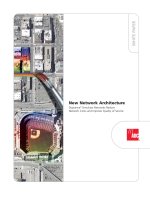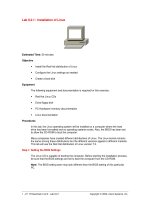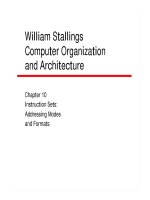COMPUTER TYPES CRITERIA OF CLASSIFICATION ppt
Bạn đang xem bản rút gọn của tài liệu. Xem và tải ngay bản đầy đủ của tài liệu tại đây (827.41 KB, 29 trang )
COMPUTER TYPES
CRITERIA OF CLASSIFICATION
HISTORY
METHODS OF DEALING WITH DATA
GENERATIONS
MANUFACTURERS
WIDELY ACCEPTED CLASSIFICATION
TYPES OF COMPUTERS
IN HISTORY
•
Pre-mechanical computers
•
Mechanical computers
•
Electronic computers
•
Optical computers
•
Biological computers
Pre-mechanical computers
• an example of a
computer with no
moving parts
• transforms information
about stellar and
planetary positions into
information about
important dates and
events (harvests, etc.)
Stonehenge
Mechanical computers
early
designs for
more
traditional
computers -
based on
mechanical
techniques.
Slide rule
Abacus
Electronic computers
Optical computers
•
current research in computer architecture
includes much work on the design of
computers which use light beams to perform
computation; these machines should be
smaller, faster and cooler than current
electronic machines
Biological computers
• computers based on DNA: problems are
encoded on strands of DNA which are mixed
in solution and react to form DNA-coded
answers
COMPUTER TYPES
CRITERIA OF CLASSIFICATION
HISTORY
TWO BASIC KINDS
GENERATIONS
MANUFACTURERS
WIDELY ACCEPTED CLASSIFICATION
ANALOG COMPUTER
1. Analog computers measure the continuous
change in something
–
Current in a wire
–
Movement of the tide
–
Rate at which a wheel turns
2. More complicated to build than digital computers
3. Analog computers are very rare today
DIGITAL COMPUTERS
1. Use discrete numbers (whole digits) to control
the electrical circuits
2. Built of switches that are either on or off
–
Can not have values in-between 0 or 1 like the
analog computer
–
1 turns the switch on
–
0 turns the switch off
3. Almost all computers built today are digital
computers
COMPUTER TYPES
CRITERIA OF CLASSIFICATION
HISTORY
TWO BASIC KINDS
GENERATIONS
MANUFACTURERS
WIDELY ACCEPTED CLASSIFICATION
First Generation - Vacuum Tubes
1. From 1946 to 1956
•
did from 2,000 to 16,000 additions per
second
•
Had main memory 100 bytes to 2 kilobytes
2. Used vacuum tubes
3. Very large machines
•
special rooms to house them with air
conditioning
•
specially trained technicians to run &
maintain
Second Generation - Transistors
1. From 1959 to around 1965
2. Smaller, faster, and more reliable
used transistors
6,000 to 3,000,000 operations/s
main memory 6 kilobytes to 1.3 megabytes
Contained in four cabinets about 6 feet high
by 4 feet wide, each weighing 250 pounds
3. one-tenth the price of a 1
st
Generation
4. become common in larger businesses
and universities
Third Generation - Integrated Circuits
1. Form 1965 to around 1972
2. Used integrated circuits – many transistors
on one piece of silicon
3. Smaller, faster, more reliable, and lower in
price
–
Size of a stove or refrigerator, some can fit on
desktops
–
Can do 100,000 to 400,000,000 operations per
second
–
Cost about one-tenth the amount of second
generation computers
4. Computers become very common in
medium to large businesses
Fourth Generation - Microprocessors
1. From 1972 until now
2. Used large scale to very large scale integrated circuits
–
Put more than one IC on a silicon chip
–
Can do more than one function
3. smaller, faster, more reliable, and lower in price
–
Size of a television or much smaller
–
Can do 500,000 to 1,000,000,000 operations/second
–
Cost one-tenth, or less, the amount of third generation
4. very common in homes and business
Future Computer Generations
1. Most likely the following will happen to
computer technology
–
It will become lower in price
–
Computers will become smaller and faster
–
Computers will have larger memories and
more storage space
2. Computers will become an integral part of
everyone's life
HISTORY
TWO BASIC KINDS
GENERATIONS
MANUFACTURERS
WIDELY ACCEPTED CLASSIFICATION
COMPUTER TYPES
CRITERIA OF CLASSIFICATION
COMPUTER TYPES
CRITERIA OF CLASSIFICATION
HISTORY
TWO BASIC KINDS
GENERATION
MANUFACTURER
WIDELY ACCEPTED CLASSIFICATION
WIDELY ACCEPTED WAYS
•
SIZE (Early days): mainframe, minicomputer,
microcomputer.
•
SIZE (Now): Floortop, Desktop, Laptop,
Palmtop, Wearable.
•
POWER: Supercomputer, server, enterprise
server (mainframe), mid-range server
(minicomputer), PC.
PC
•
computer designed for general use by a
single person.
•
PCs were first known as microcomputers
because they were a complete computer but
built on a smaller scale than the huge
systems in use by most businesses.
DESKTOP
•
A PC that is not designed for
portability.
•
you will set the computer up in a
permanent location.
•
Most desktops offer more power,
storage and versatility for less cost
than their portable brethren.
Laptop
•
Also called notebooks.
•
Laptop are portable computers that
integrate the display, keyboard, a pointing
device or trackball, processor, memory and
hard drive all in a battery-operated package
slightly larger than an average hardcover
book.
Palmtop
•
More commonly known as Personal
Digital Assistants (PDAs)
•
palmtops are tightly integrated
computers that often use flash memory
instead of a hard drive for storage.
•
usually do not have keyboards but rely
on touchscreen technology for user
input.
•
A slightly larger and heavier version of
the palmtop is the handheld
computer.
Workstation
•
A desktop computer that has a
more powerful processor, additional
memory and enhanced capabilities
for performing a special group of
task, such as 3D Graphics or game
development.
Server
•
A computer that has been optimized to
provide services to other computers over a
network.
•
Servers usually have powerful processors,
lots of memory and large hard drives.









